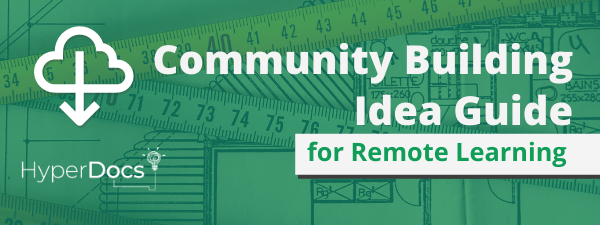Building Community and Connectedness Remotely
After months of shelter in place and limited opportunities for social engagements, students have been isolated in their homes and many have experienced different versions of trauma. We know that when students feel connected to their classroom community, then they have an increased level of engagement, retention, participation, and motivation. Therefore, now more than ever, it is important to plan ways to create a connected classroom community.
Last spring, when educators shifted to remote instruction, there was an advantage that they had because students and teachers had already spent multiple months of the school year getting to know each other in the classroom. Classroom teachers were able to leverage the relationships that were previously established in an effort to support a smoother transition into a remote learning environment. But starting a new school year remotely means that we will not have that same face to face time with students. This leads to the question - How do we build a connected classroom community through a computer screen? How do we create connections to help students get to know each other?
When shifting instructional practices to online learning, there are key components that will remain the same and some that will look and feel different because of the technology integration. Either way - let’s work together this school year to create that same good old classroom vibe!
Looking for some practical resources to build community and connect? Check out this free guide of ideas and suggestions for how to connect and build community remotely with each of these groups:
- Teacher to Student
- Student to Student
- Teacher to Home Care Giver(s)/Parent(s)
- Teacher to Teacher
Have more ideas? Leave comments below and we can add to the resources.
Download the Community Building Idea Guide for Remote Learning here!
Community building instructional practices that remain the same whether we are in classrooms or teaching remotely include:
Dedicated Time:
Building a classroom community doesn’t just happen with a couple of back to school lessons. Community building is intentionally integrated into lesson design all year long. Each activity is a stepping stone on a pathway to an inclusive classroom community.
Consistent Routines:
The classroom community will develop when students can anticipate dedicated time to connect. This creates a sense of safety for students. When putting these systems in place, consider how many students and families you are serving. Before implementing processes, be sure to consider your own sense of balance. Only integrate practices that you feel have an authentic impact. If you try something and it isn’t working, don’t be afraid to abandon that practice.
Integrate Community Building into Lesson Design:
Every time students come together to learn, there is an opportunity to build in a quick check-in, time for collaboration, or a reflection activity. By asking questions beyond content, students will develop relationships. Consider asking questions that allow students to express their emotions, reveal their likes/dislikes, and problem solve.
Teach Connectedness Explicitly:
There will be times to design an entire lesson with a single goal of developing a positive classroom community. Use the #HyperDocs shared below in the eBook or design your own. Also - check out the CSEL Social and Emotional Learning lesson plans for more ideas.
Potential shifts in instructional practices for building community remotely:
Gamify:
Have you ever listened to a tween or teen giggle and play online video games while chatting with friends? Many students are experts in online gaming and everyone loves a good game. Turning lessons into games will provide students with shared classroom experiences and this will help to build relationships amongst groups of students.
Socialize:
Have you ever felt connected after scrolling Facebook or Instagram? In the past few months have you leveraged technology to connect with family members or old friends via Zoom or Facetime? If so, then you are using technology to connect with your community online. Like social media, the same positive connections can evolve in your classroom. Build community this year by establishing one place for students to share stories, ask questions, post photos, and videos. Find the web tool that works best for the age of your students and create a shared digital space for them to connect. It can be as simple as a group Gchat, a discussion board in Google Classroom or Seesaw, or aPadlet with open commenting.
Groups:
With technology, a community can be defined in any way that we decide to design it. We have the potential to truly personalize learning by teaching across class periods and by combining subject areas. Consider the many different ways to group students based on academic, social/emotional, and behavioral goals. There will be times to connect individually with students and to connect with small groups of students. Groups might have similar academic needs or they might be working together on mastering content. Facilitating different groups of learners will provide students with opportunities to work with a variety of classmates and to feel connected to the classroom.
Still curious about how to use the resources in the idea guide? Join us this Saturday as we will talk more about how to create a connected classroom remotely! Log in at hyperdocs.co/live.

